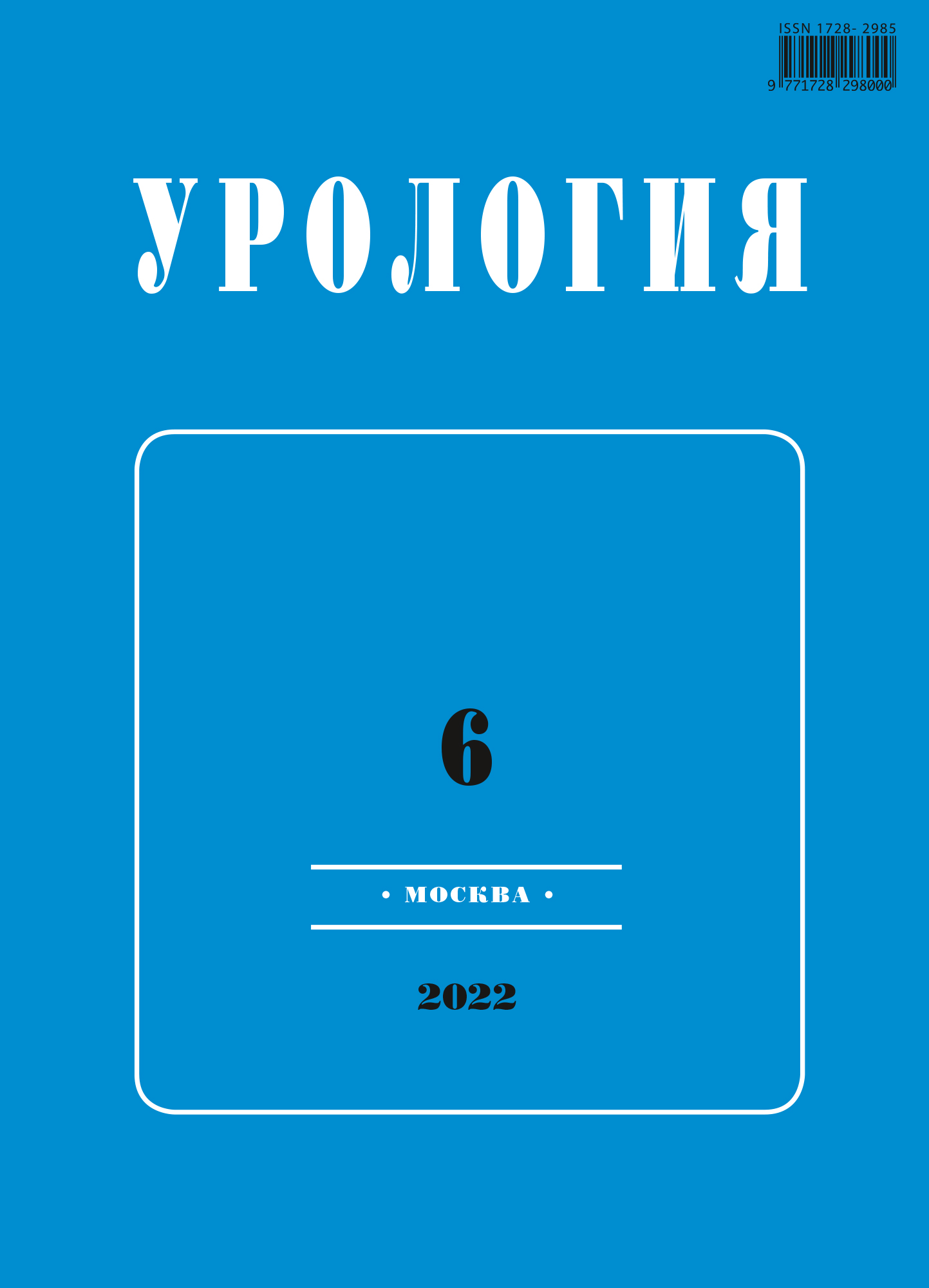Dissolution of uric acid stones in the ureter
- Autores: Frolova E.A1, Tsarichenko D.G1, Saenko V.S1, Rapoport L.M1, Glybochko P.V1
-
Afiliações:
- FGAOU VO I.M. Sechenov First Moscow State Medical University
- Edição: Nº 6 (2022)
- Páginas: 56-60
- Seção: Articles
- URL: https://journals.eco-vector.com/1728-2985/article/view/277127
- DOI: https://doi.org/10.18565/urology.2022.6.56-60
- ID: 277127
Citar
Texto integral
Resumo
Palavras-chave
Texto integral
Sobre autores
E. Frolova
FGAOU VO I.M. Sechenov First Moscow State Medical University
Email: frolo-ekaterin@yandex.ru
Ph.D., urologist of the UKB №2 Moscow, Russia
D. Tsarichenko
FGAOU VO I.M. Sechenov First Moscow State Medical University
Email: tsarichenkodg@yandex.ru
Institute of Urology and Reproductive Health; h.D., MD, professor Moscow, Russia
V. Saenko
FGAOU VO I.M. Sechenov First Moscow State Medical University
Email: saenko_vs@mail.ru
Institute of Urology and Reproductive Health; MD, professor Moscow, Russia
L. Rapoport
FGAOU VO I.M. Sechenov First Moscow State Medical University
Email: leonidrapoport@yandex.ru
Institute of Urology and Reproductive Health; Ph.D., MD, professor, Deputy Director on Medical care Moscow, Russia
P. Glybochko
FGAOU VO I.M. Sechenov First Moscow State Medical University
Email: rektorat@sechenov.ru
Institute of Urology and Reproductive Health; Ph.D., MD, academician of RSA, Rector, Director Moscow, Russia
Bibliografia
- Sorokin I., Mamoulakis C., Miyazawa K. et al. Epidemiology of stone disease across the world. World Journal of Urology. 2017:1-20.
- Борисов В.В., Дзеранов Н.К. Мочекаменная болезнь. Терапия больных камнями почек и мочеточников. М., 2011. 88 с.
- Кузьмина Ф.М. Метафилактика мочекаменной болезни на основе прогнозирования риска рецидива заболевания: Кузьмина Фарида Мансуровна Саратов, 2010.
- Ненашева Н.П., Поповкин Н.Н., Орлова Е.В. и соавт. Динамика урологической заболеваемости по регионам Российской Федерации. Пленум правления Российского общества урологов: Материалы, Саратов, 1998:215-216.
- Голованов С., Сивков А., Дзеранов Н. и соавт. Распространенность метаболических типов мочекаменной болезни в Московском регионе: сравнительный анализ за период с 1990 по 2000 г. Экспериментальная и клиническая урология; 2010;3:27-32.
- Lieske J.C., Rule A.D., Krambeck A.E., et al. Stone composition as a function of age and sex. Clinical Journal of the American Society of Nephrology. 2014;9(12):2141-2146.
- Knoll T., Schubert A.B., Fahlenkamp D. et al. Urolithiasis through the ages: data on more than 200,000 urinary stone analyses. The Journal of urology. 2011;185(4):1304-1311.
- Daudon M, Dore J-C, Jungers P et al. Changes in stone composition according to age and gender of patients: a multivariate epidemiological approach. Urological research. 2004;32(3):241-247.
- Daudon M., Lacour B., Jungers P. High prevalence of uric acid calculi in di abetic stone formers. Nephrology Dialysis Transplantation. 2005; 20(2):468-469.
- Marchini G.S., Sarkissian C., Tian D. et al. Stone composition and urinary stone risk: a matched case comparative study. The Journal of urology. 2013;189(4):1334-1339.
- Pak C., Sakhaee K., Moe O. et al. Biochemical profile of stone-forming patients with diabetes mellitus. Urology. 2003;61(3):523.
- Пытель Ю.А., Золотарев И.И. Уратный нефролитиаз. М: Медицина. 1995, 145 c.
- Wiederkehr M.R., Moe O.W. Uric acid nephrolithiasis: A systemic metabolic disorder. Clinical reviews in bone and mineral metabolism. 2011; 9(3-4):207-217.
- Abou-Elela A. Epidemiology, Pathophysiology And Management Of Uric Acid Urolithiasis: A Narrative Review. Journal of Advanced Research. 2017.
- Skolarikos A., Jung H.U. et al. EAU guidelines on urolithiasis 2022. EAU Guidelines. Edn. presented at the EAU Annual Congress Amsterdam 2022. Available at: uroweborg/guidelines/urolithiasis/.
- Калинина С.Н., Кореньков Д.Г., Мелконян А.Б. Опыт применения цитратной смеси Блемарен у больных с камнями мочеточников. Клиническая нефрология. 2013(5):30-32.
- Rodman J.S., Williams J.J., Peterson C.M. Dissolution of uric acid calculi. The Journal of urology. 1984;131(6):1039-1044.
- Dion M., Ankawi G., Chew B. et al. CUA guideline on the evaluation and medical management of the kidney stone patient-2016 update. CUAJ. 2016;10(11-12):E348.
Arquivos suplementares








